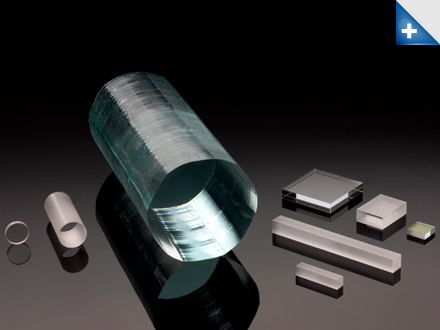
Crystals doped with trivalent ytterbium (Yb3+) have demonstrated significant potential for application in compact, efficient, diode-pumped laser systems.[1-4] The Yb3+ ion has only two manifolds, the ground 2F7/2 and the excited 2F5/2 which are separated by approximately 10,000 cm-1. As a result, Yb3+doped materials have spectroscopic and laser properties that are advantageous for high energy 1 µm laser systems. In particular, Yb3+ doped materials should not suffer from concentration quenching, upconversion, or excited state absorption. The Yb3+ ion also has a long energy storage lifetime (typically three to four times that of Nd3+ in the same host) and a very small quantum defect which reduces heat generation during lasing.
In the specific case of the host material YAG, Yb3+ has a storage lifetime of 950 µs and a quantum defect of only 8.6%. Yb3+:YAG also has a broad pump line at 940 nm that is 10 times broader than the 808 nm pump line in Nd3+YAG making the system less sensitive to thermal drift of the pump diodes wavelength. These material properties combined with the development of robust long-lifetime InGaAs pump diodes at 940 nm have made this material a superior candidate for diode-pumped high-energy lasers.
Laser systems based on SM's UP-grade Yb3+:YAG have been reported with cw output powers exceeding 430 W,[1] quasi-cw output powers of 600 W,[4] and optical to optical efficiencies of 60%.[2] Such systems have been reported to be scaleable with output powers at the kW level.
Crystals of Yb3+ doped YAG are available in a variety of dopant concentrations from 1% - 100% (e.g. Ytterbium aluminum garnet - YbAG).
Please contact us with your specific requirements or for availability and pricing of currently stocked compositions.
| Yb3+ Concentration Range | 1.0 - 100 atomic % |
| Dopant Ion Density @ 1 atomic % | |
| Y3+ Site | 1.38 x 1022 cm-3 |
| Al3+Site (IV) | 1.38 x 1022 cm-3 |
| Al3+Site (VI) | 0.92 x 1022 cm-3 |
| Emission Wavelength | 1.064 μm |
| Laser Transition | 2F5/2 → 4F7/2 |
| Intrinsic Flouresence Lifetime (≤ 15 atomic % Yb doping) | 967 μs |
| Pump Wavelength | 941 nm |
| Coefficient of Thermal Expansion | 6.14 x 10-6 K-1 |
| Thermal Diffusivity | 0.041 cm2 s-2 |
| Thermal Conductivity | 11.2 W m-1 K-1 |
| Specific Heat (Cp) | 0.59 J g-1 K-1 |
| Thermal Shock Resistant | 800 W m-1 |
| Refractive Index @ 632.8 nm | 1.83 |
| dn/dT (Thermal Coefficient of Refractive Index) @ 1064nm | 7.8 10-6 K-1 |
| Molecular Weight | 593.7 g mol-1 |
| Melting Point | 1965°C |
| Density | 4.56 g cm-3 |
| MOHS Hardness | 8.25 |
| Young’s Modulus | 335 Gpa |
| Tensile Strength | 2 Gpa |
| Crystal Structure | 8Cubic |
| Standard Orientation | <111> |
| Y3+ Site Symmetry | D2 |
| Lattice Constant | a=12.013 Å |
1) Camille Bibeau and Ray Beach, “CW and Q-switched performance of a diode end-pumped Yb:YAG laser,” Advanced Solid-State Lasers, January 27-29, 1997 Orlando, FL.
2) M. Karszewski, U. Brauch, A. Giesen, I. Johannsen, U. Schiegg, C. Stewen, A. Voss, “Advanced Tunability and High-Power TEM00-Operation of the Yb:YAG Thin Disc Laser,” Advanced Solid-State Lasers, January 27-29, 1997 Orlando, FL.
3) H. Bruesselbach and D. Sumida, “69-W-average power Yb:YAG laser,” Opt. Lett. 21, 480 (1996).
4) H. Bruesselback, D. S. Sumida, R. Reeder, and R. W. Byren, “High-Power Side-Diode-Pumped Yb:YAG Laser,” Advanced Solid-State Lasers, January 27-29, 1997
Orlando, FL.